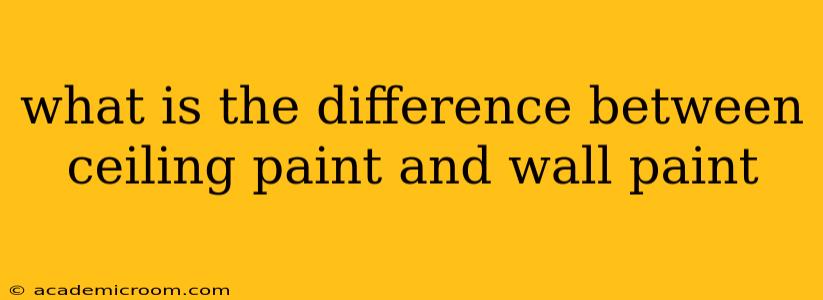Choosing the right paint for your home improvement project can feel overwhelming. While it might seem like any old paint will do, there are significant differences between ceiling paint and wall paint, and choosing the right one impacts the final look and longevity of your project. This article will delve into the key distinctions, helping you make an informed decision.
Is Ceiling Paint Different Than Wall Paint?
Yes, absolutely! While both are used to decorate interior spaces, ceiling and wall paints are formulated with different properties to suit their unique applications. Ceiling paint is designed to be easily applied to large surfaces, providing a smooth, even finish while minimizing drips and roller marks. Wall paint, on the other hand, often prioritizes washability, scrub resistance, and color vibrancy.
What Makes Ceiling Paint Unique?
Several key characteristics set ceiling paint apart:
-
Lower sheen: Ceiling paints typically have a low sheen or matte finish. This helps to hide imperfections in the ceiling, like minor cracks or texture variations, preventing them from being highlighted by light reflection. A high-gloss finish on a ceiling would only accentuate these flaws.
-
Better for hiding imperfections: The lower sheen, combined with the often-thicker consistency, makes ceiling paint excellent at masking blemishes. This is crucial, as ceilings are often more difficult to prepare perfectly than walls.
-
Faster drying time: Because ceilings are large areas, a paint that dries quickly minimizes disruption and allows for a quicker project completion.
-
Stain-resistant properties: While not all ceiling paints are specifically labeled as stain-resistant, many are formulated with properties that repel everyday dirt and dust more effectively than standard wall paints.
What are the Key Features of Wall Paint?
Wall paints are designed with different priorities in mind:
-
Washability: Walls are more prone to scuffs, marks, and spills. Wall paints are usually formulated with a higher scrubbability rating, allowing them to withstand regular cleaning without damage to the finish.
-
Wider range of colors and sheens: Wall paints are available in a vast spectrum of colors and sheens, from matte to high-gloss, offering extensive stylistic options. This allows for greater creative flexibility in your interior design.
-
Durability: While ceiling paints are durable enough for their intended use, wall paints often prioritize lasting power and resistance to wear and tear.
Can I Use Wall Paint on the Ceiling?
While technically you can use wall paint on your ceiling, it's generally not recommended. The higher sheen could accentuate imperfections, and the slower drying time can lead to drips and uneven coverage on a large surface. It might also result in a less desirable, uneven final finish.
Can I Use Ceiling Paint on the Walls?
Using ceiling paint on the walls is also generally discouraged, particularly in high-traffic areas or spaces requiring frequent cleaning. The lower washability and potentially thinner consistency make it less resistant to scrubbing, potentially leading to damage or color loss over time.
What Type of Paint is Best for a Bathroom Ceiling?
For bathroom ceilings, you'll want a paint that offers good moisture resistance and mildew resistance. Many ceiling paints are formulated with these qualities, but be sure to check the product label for specific claims. Proper ventilation in the bathroom is also crucial to prevent mildew growth.
How Do I Choose the Right Paint for My Project?
When selecting paint, always carefully read the product label. Look for key features such as sheen level, washability, drying time, and any specific performance characteristics (e.g., mildew resistance). Consider the specific needs of the room and the surface you are painting. If you're unsure, consulting with a paint professional at a home improvement store is always a good idea.
By understanding the distinct formulations and properties of ceiling and wall paints, you can ensure a successful and long-lasting finish for your next painting project. Remember, choosing the right paint is crucial for achieving a professional look and maximizing the longevity of your work.
